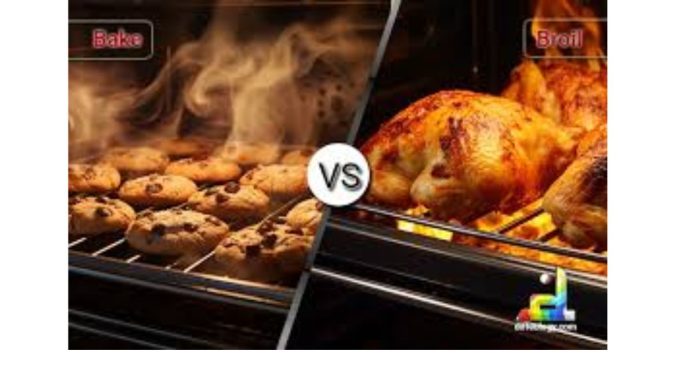When it comes to cooking techniques, baking and broiling are two methods that often get confused. While both involve the use of an oven, they are distinct processes with unique applications and outcomes. Understanding the difference can help you achieve the perfect dish every time.
Baking: Slow and Even Cooking
Definition: Baking is a cooking method that uses indirect, dry heat to cook food evenly. The heat comes from the oven’s surrounding environment, usually with the temperature set between 300°F and 400°F.
How It Works: In baking, the oven’s heating elements (top and bottom) work together to create an even temperature throughout the oven. This gentle, all-around heat cooks food slowly, making it ideal for:
- Cakes, cookies, and pastries
- Breads
- Casseroles
- Roasts
Key Characteristics:
- Temperature Control: Baking requires precise temperature settings to ensure consistent results.
- Time: Baking typically takes longer than broiling, as it relies on gradual heat transfer.
- Versatility: Almost anything can be baked, from sweet treats to savory dishes.
Broiling: Quick and Intense Heat
Definition: Broiling uses direct, high-intensity heat from the oven’s top heating element to cook food quickly.
How It Works: When broiling, food is placed close to the top of the oven, directly under the heating element. This direct exposure to intense heat cooks the surface of the food rapidly, making it ideal for:
- Browning or crisping the tops of dishes
- Cooking thin cuts of meat, poultry, or fish
- Melting cheese or caramelizing toppings
Key Characteristics:
- High Heat: Broiling typically involves temperatures above 500°F.
- Speed: Broiling is fast, often requiring just a few minutes of cooking time.
- Surface Focus: This method is excellent for achieving a charred, crispy, or caramelized finish.
Key Differences at a Glance
| Aspect | Baking | Broiling |
|---|---|---|
| Heat Source | Indirect heat from all sides | Direct heat from above |
| Temperature | Moderate (300°F – 400°F) | High (500°F or more) |
| Cooking Time | Longer | Shorter |
| Best For | Even cooking of larger items | Quick browning or crisping |
When to Bake vs. Broil
- Bake when you want to cook food thoroughly, ensuring an even texture and doneness. Examples include baking a lasagna, roasting vegetables, or making a cake.
- Broil when you want to quickly add color, crispness, or caramelization. For example, broil a steak for a seared finish or melt cheese on a casserole.
Tips for Success
- Use the Right Tools: Baking often requires pans or trays that distribute heat evenly, while broiling works best with broiler pans or wire racks to allow airflow.
- Monitor Closely When Broiling: Because of the high heat, broiling can easily lead to burning if not watched carefully.
- Experiment: Some dishes benefit from both methods. For instance, you can bake a casserole to cook it thoroughly and finish with broiling to brown the top.
Baking and broiling are both essential techniques that offer different results. Baking is all about slow and even cooking, while broiling provides quick, intense heat for finishing touches. By understanding these methods, you can elevate your culinary skills and enjoy perfectly cooked meals every time.


